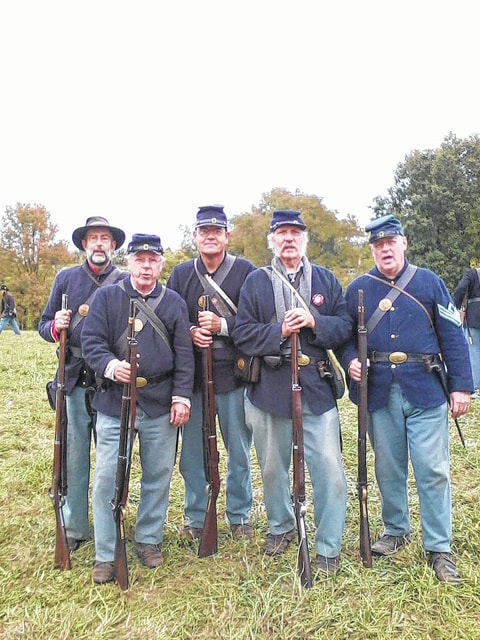
SIDNEY — Veteran Civil War re-enactors Michael (Mic) O’Halloran and Bruce Grashel will be two of the speakers at Sidney, Ohio’s Civil War Living History Weekend September 17 and 18. The two will discuss the lives of ordinary soldiers, focusing on the 10th Ohio Volunteer Infantry (OVI).
The 10th Ohio was mustered into service on May 7, 1861, at Camp Harrison (Cincinnati) in response to President Abraham Lincoln’s call for 75,000 volunteers to suppress the rebellion. The regiment’s term of service was for three months, as the early thinking by the leadership of both sides was that the war would be of short duration.
After a few days of training, the regiment marched to Camp Dennison on May 12, a distance of seventeen miles. The completed the march in just three hours and forty-five minutes. They continued training there until June 3.
Whitelaw Reid, the author of Ohio in the Civil War (published in 1895) wrote that “the regiment rapidly acquired a knowledge of its military duties. In its ranks were many old soldiers, who had studied the art of war, and were not unfamiliar with scenes of actual combat. Some had served in European armies, and not a few had been through the Mexican war. It was at this time that the regiment was inspected by General (George) McClellan, who expressed his admiration of it in very high terms.”
“The Tenth was a three-months’ regiment, and already half of its time had expired. It became evident that troops were needed for a longer term of service, the Tenth, almost as a whole, volunteered for three years; and on the 3d of June it was mustered into the service as a three-years’ regiment.”
“The regiment was composed of eight companies of Irish-speaking immigrants, and two companies of German-speaking immigrants,” O’Halloran explained. O’Halloran, his own family having emigrated from Ireland, will talk about the Irish experience.
Grashel’s great, great, great grandfather fought in the 10th Ohio. He will talk about the German experience in the regiment.
“Many of the German and Irish immigrants had similar experiences when they arrived in America. They faced determined discrimination by nativists. That discrimination included negative stereotyping that created an environment that excluded anyone of foreign nationality,” O’Halloran stated.
“The Irish and German immigrants found themselves fighting hard to overcome the oppression they faced. By creating social networks through politics, religion, and in business, the immigrants challenged the social stigmas that was attached to them because of their cultural background,” O’Halloran continued. “Through hard work and determination, they were able to eventually enjoy the American dream.”
“Despite their cultural differences, these Irish and German soldiers got along well together. One day, one of the officers asked one of the German soldiers who spoke fluent English how it was that they got along so well,” O’Halloran stated.
“What’s not to like?” the soldier responded. “They like cabbage, they like beer and they don’t like you. They are just like us!”
The 10th Ohio became known as the “Bloody 10th” as a result of their capabilities as soldiers. During their three-year enlistments, the soldiers fought valiantly in major battles including Carnifex Ferry, Perryville, Stones River, the Tullahoma Campaign, Chickamauga, Chattanooga, Lookout Mountain, Missionary Ridge, the Atlanta Campaign and Resaca.
After the Battle of Resaca (May 14–15), they were ordered to the rear to be mustered out. The 10th Ohio disassembled on June 3, 1864. Seventy-five enlisted men whose terms of enlistment had not expired were assigned to the 18th Ohio.
“We are looking forward to Sidney’s event,” O’Halloran stated. “It is the talk of the reenacting world. There are so few events held in Ohio – it’s going to be nice to attend an event and not have to drive for hours to get there. In addition, having the opportunity to utilize the park with its many terrain features makes this a unique opportunity for reenactors and spectators alike.”

